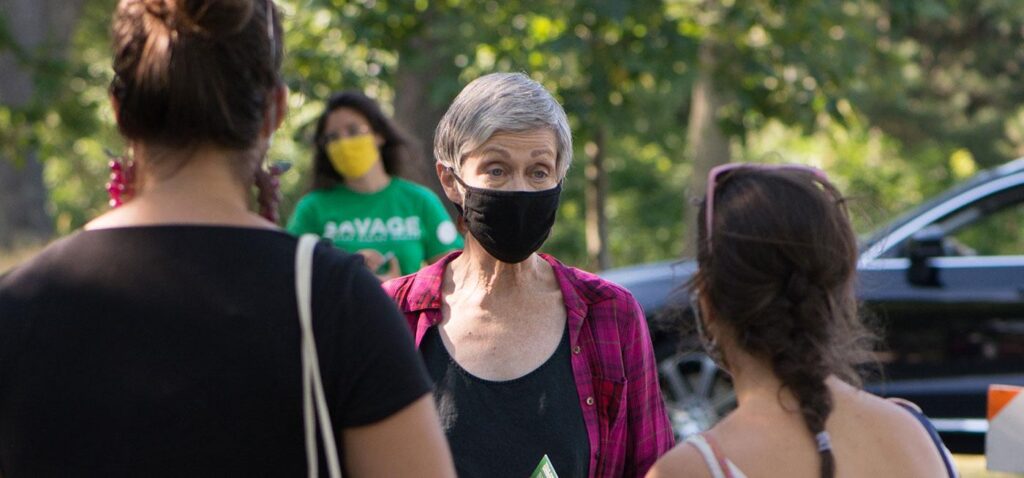Lisa Savage Campaign Shows How Ranked-Choice Voting Changes the Landscape for Greens
Share

By Dave Schwab, Communications Director for Lisa Savage for US Senate 2020
Overall, 2020 was perhaps the toughest year for US Greens yet. After four years of being relentlessly scapegoated for the Democrats’ losses in 2016, Greens faced unprecedented hostility from the corporate political and media establishment in 2020. One notable exception to this rule was in Maine, where Lisa Savage ran a strong grassroots campaign for the US Senate under the system of ranked-choice voting established by popular statewide votes in 2016 and 2018. As communications director for the Savage campaign, I saw firsthand how ranked-choice voting changed the landscape for a Green candidate – although much work remains to be done to truly level the playing field.
Lisa Savage is a kindly, straightforward teacher, grandmother, and activist from the small rural town of Solon, Maine. To the extent she had any name recognition, it was from her role in frequent protests calling on the naval contractor Bath Iron Works to convert from manufacturing warships to producing green energy technology. In a race that also included longtime incumbent Republican Susan Collins (who won in the first round with 51 percent of the vote) and Democratic speaker of the Maine House Sara Gideon(receiving 42 percent of the vote), Savage (garnering 5 percent) was persuaded to run largely by the fact that ranked-choice voting would be in play. Although ballot access restrictions making it nearly impossible to get on the ballot as a Green forced her to take the independent route to ballot access, she still wore her Green affiliation proudly and as often as not, was identified in the media as a Green candidate.
2020 also being the year of Bernie Sanders’ second presidential run, there was a noticeable trend of progressives challenging the establishment in the Democratic Party. In Maine, there were 2 progressive Democratic challengers to Gideon, Bre Kidman, and Betsy Sweet. After Gideon won handily with the full weight of the establishment behind her, Kidman endorsed Savage, the first time in memory that a Democratic primary candidate endorsed a Green. Savage gained such support with her strong stance on a demilitarized Green New Deal, Medicare for All, and student debt cancellation. In contrast, Gideon offered a typical corporate centrist campaign, with vague positions framed around the need to get Collins and Trump out and support Biden.
While the sudden onset of the Covid-19 pandemic brought grassroots activity and fundraising to a screeching halt, the establishment victory in the Democratic primary helped bring renewed support to the Savage campaign. From October 2019 to November 2020, the campaign raised just shy of $200,000, a record for a Green campaign in Maine. Meanwhile, the Gideon and Collins campaigns vied to raise tens of millions from across the country, with tens of millions more in dark money pouring in. The flood of outside money and endless barrage of negative ads was a frequent topic of complaint in Maine media, yet few of those journalists saw fit to give a platform to the only grassroots-funded non-millionaire candidate.
The apparent effect of ranked-choice voting on the Savage campaign was to turn Greens in the mainstream media’s eyes from undesirable third-class citizens into second-class citizens. The big-money candidates still got the lion’s share of media attention, but
Lisa Savage did get much more coverage than other 2020 Green campaigns, including the presidential campaign.
Notably, she was included in the first four televised debates of the race, where her strong performances brought in new waves of recognition and support. National media coverage of the race, which otherwise would almost certainly have treated a Green candidate only as a “spoiler”, instead tended to focus on how Savage would impact the result under ranked-choice voting. There were some unexpected twists to the media reception, such as the mainstream Bangor Daily News giving Savage equal space with the other candidates in a series of issue-based articles, while the Maine-based progressive independent site Common Dreams (which had given Greens some decent coverage in past years) completely ignored frequent coverage requests from campaign staff and supporters.
Another effect of ranked-choice voting was to make campaigning easier and more rewarding. Instead of being focused on the horse race and the perceived need to fall in line behind the “lesser of two evils”, voters were much more receptive to an independent issue-based campaign. For those who expressed concern about keeping Collins from winning, we let them know they could “rank Lisa first” and still “vote blue number two”. Frequently people would send angry messages demanding that Lisa drop out to benefit Gideon, but when we explained that ranked-choice voting effectively resolved their concerns, they often responded with apologies and a more open-minded attitude to the campaign.
Not surprisingly, the biggest detractors of ranked-choice voting were the corporate parties. Among Gideon supporters, there was a whisper campaign spreading the idea that it was unsafe to rank one’s vote because the GOP would try to have the US Supreme Court overturn RCV after the election. While this argument had no logical basis – the Maine Supreme Court had already ruled decisively that RCV was decided state law – it was still an effective way to perpetuate fear-based voting, and that was clearly the goal of many influential Democrats. Savage supporters heard these talking points from paid canvassers for Gideon and phone bankers from Planned Parenthood. While one of the progressive Democrats who lost in the primary endorsed Savage, the other, Betsy Sweet, was quoted in the media warning voters not to rank their choices.
Aside from the Democratic Party power structure, many of the progressive issue advocacy groups and activists were hesitant when faced with the opportunity to buck the establishment and back a campaign that fully aligned with their stated goals. As one example, after the Democratic primary, the Sunrise Movement made some inquiries about the Savage campaign’s organizing infrastructure but declined to endorse the only candidate for a Green New Deal. While a few grassroots groups endorsed Savage, including the Maine chapter of Democratic Socialists of America, most established groups balked at the opportunity to assert their power by urging voters to give their first ranking to a candidate who shared their goals. It seems that with ranked-choice voting still new in the political landscape, and only active in federal races for the 2020 cycle, these players considered it too risky to step outside the Democratic Party’s orbit.
On Election Day, Lisa Savage received over 40,000 first-choice votes, 5% of the total, while Collins took 51%, meaning counting ended after the first round. 5% was a fairly impressive result for a campaign that was outspent 1000-1 by its opponents, but it was disappointing that Collins’ majority win meant the country didn’t get to see multiple rounds of ranked-choice voting in this nationally-watched race. While Savage did better than almost any other candidate outside the two-party system, the pandemic had severely hindered the kind of grassroots campaigning and fundraising the campaign would have needed to pull off an upset win. In the end, though, the Lisa Savage for Senate campaign set a shining example for future Green campaigns and showed the early promise of ranked-choice voting to bring progress to a stagnant political system.









I’m a Florida Green who made a modest contribution to Savage’s campaign.
Given that Maine voters not only voted for RCV but fought the legislature which tried not to implement it, I find it incomprehensible that 93.4% of those voters listed either Collins or Gideon as their first preference.
Did Maine voters not understand RCV? If not, why did they buck the establishment to get it? If They did understand it, how could only 6.6%
rank a third party candidate first?
My email to the campaign about this after the campaign went unacknowledged. And this piece strikes me as either a naive rose tinted view or a deliberate attempt to ignore uncomfortable facts and questions
Oh, whoopee. Even if Savage doubled, tripled or even improved her vote five fold because of RCV, 5% in an RCV race strikes me as pretty pathetic. The obvious question is, has ballot tampering been definitely ruled out?
Candidate’s analysis of our campaign here: https://went2thebridge.org/2020/11/10/our-work-continues/